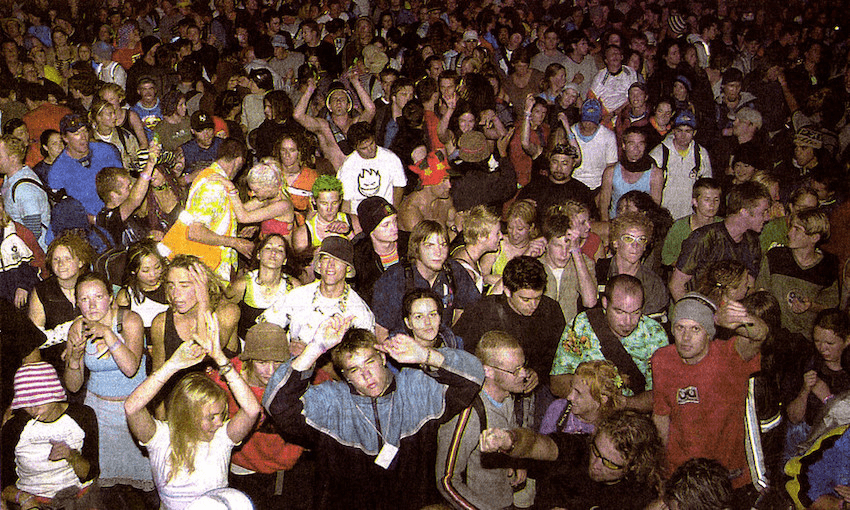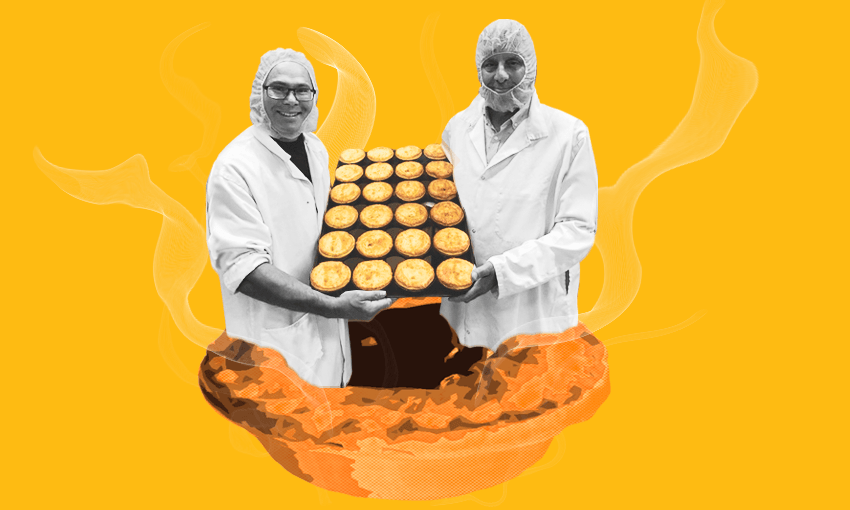Before Splore, there was a South Island music festival that celebrated ‘unity through diversity’ in the final years of the 20th century. In this piece originally published on AudioCulture, Gary Steel tells the tale of The Gathering.
To paraphrase a famous hippie festival homily, if you can remember it you probably weren’t there. Despite its relatively small audiences and short lifespan, The Gathering has gone down as New Zealand’s most transformative, influential and downright legendary music festival – at least to the subcultures it represented. Held near Nelson each New Year for six years, The Gathering represented New Zealand’s then nascent electronic music scene in all its tribal colours.
Tripping the light fantastic. It’s a phrase associated with dancing to music throughout the 20th century but takes on added significance when referring to psychoactive music and culture festivals like The Gathering.
At the tail end of 1996, electronic music fans of all stripes and affiliations and from far and wide converged on Canaan Downs near Nelson, to bring in the New Year in a fashion that would see The Gathering etched into our collective memory as the most potent representation of the “new thing”, a crystallisation of synthetic sounds and organic participatory spirit. Four thousand revellers would dance until they dropped, enhanced not by alcohol – which was banned from the event – but typically by hallucinogenic drugs, and sometimes just the transporting qualities of the music itself. There was no violence and no casualties.
Inspired by the Goa trance phenomenon that had fired up international outdoor festivals earlier in the decade and with the main stage devoted to variations of that style, the festival promoters sensibly added five alternative stages as well to represent the diversity of electronic music at the time, including a stage for dub, trip-hop and drum & bass, another for house, funk and disco, two separate ambient areas (one electronic, one acoustic) and a stage for the really banging stuff, hardcore house and industrial.
Its timing was perfect. Electronic dance culture in New Zealand had really started building up a head of steam by this point, and The Gathering brought together a confluence of DJs and music creators eager to share their wares with an audience inspired by dance culture’s levelling ability to bring people together for a good time that was a world away from the typical rock gig.
To many repeat attendees, that first iteration of The Gathering offers fond memories as it had the freshness of a new event, great weather in an amazing setting, offered a variety of new and exciting acts – including Salmonella Dub, Unitone Hi-fi and Jed Town’s ICU – and with its artworks and lighting displays and cast of roving stilt-stalking, fire-eating freaks, the “vibe” was just right.
But The Gathering was actually the bastard child of a previous festival, Entrain, which had been the product of a messy divorce. Held in the three years prior to the first The Gathering, Entrain was a more flagrantly hippie, “tribal” style festival with its musical emphasis on trance. After the 1995 Entrain, its technical crew took off on a research mission to Europe, and while they were away, its core crew put the concept that became The Gathering together, with more of an emphasis on musical diversity and better production values. Organised by Grant Smithies, Josephine Cachemaille, Mel Rutherford-Dower, Tim Owens and Murray Kingi, The Gathering would turn out to be a hugely successful attempt at capturing the zeitgeist.
Kingi had started out as a DJ and sound engineer at Entrain, but became frustrated at the festival’s limited ambitions. In a 2003 piece by Perry Williams he’s quoted as saying: “I loved the idea of the outdoor party but I really just felt playing trance was pigeonholeing people into a particular form.” Kingi’s emphasis was on ramping up the production values, while Smithies largely inspired the versatile approach to music programming.
Josephine Cachemaille held the role of general manager and event coordinator for the first two Gatherings, in 1996/97 and 1997/98. She ensured the events had a strong harm reduction/health and safety focus, and later went on to write national dance party event guidelines for the Ministry of Health.
With no financial backing the team took a huge punt that the festival would work, and that the crowds would come to the remote site. It paid off, and got the ball rolling for what would become increasingly ambitious festivals over the next five years. As one report rhapsodised: “Communities sprang up in unlikely places. People wandered aimlessly in the woods and stumbled across tribal drumming circles or groups of strangers blissfully staring at the sky.”
For the organisers, it was a trial by fire, and a dozen crew members stayed on for several weeks after the event to clean up.
For many, the 1996/97 and 1997/1998 festivals define The Gathering’s ethos. Set at Canaan Downs, the first (1996/97) festival featured an expanded line-up, beefed-up production values, and the major media coverage brought big crowds. Eight-thousand punters turned up to revel under the stars, despite the protestations of Sergeant Jim Burrows of the Motueka police, who suggested that the venue be changed, “preferably to somewhere in the North Island.” It was also the year that a proper documentary was made about the festival.
After being involved in the first two events, Josephine Cachemaille and Grant Smithies resigned by the time of the 1998/99 festival, citing disagreements over how the budget was being managed.
The next event remained successful (for many it was the best-ever iteration of The Gathering.) Once again, there were eight-thousand attendees and the branding was cemented with an on-site radio station and a Kog label CD release.
The looming problem, however, was the spectre of budget blowouts and in 1998/99, despite healthy attendance, costs had spiralled by 1000 percent, and the festival lost around $60,000.
And then, the next year, it all went horribly wrong. The Gathering had never been profitable, largely because of the huge costs of putting a festival on in the middle of nowhere. Hiring and transporting loads of equipment up rickety roads to an obscure location was prohibitively expensive. If The Gathering’s financial footing was already precarious, then the disastrous turn-of-events at the 1999 festival – which was affectionately named G2000 – would send it down an irreparable spiral of debt.
Auckland’s Sweetwaters Festival in January 1999 had collapsed, owing millions in unpaid bills, and suppliers burnt by that less-than-sweet experience suddenly demanded money upfront from The Gathering.
The turn-of-the-century festival was, on the face of it, The Gathering’s biggest turnout yet. Numbers were well up but there were at least 5000 forged tickets, and the costs involved in getting more equipment, more acts and 1500 crew made it a risky exercise; one which drew much criticism from former organisers.
And then, there was the rain. The Gathering’s gorgeous unspoiled location was awe-inspiring in good weather but, even then, temperatures dipped towards zero during the night. This time, the whole place was flooded, and The Gathering turned into a rescue mission. One frequent Gathering punter, electronic musician Adrian Dentice, describes it thus: “All these kids had just turned up in their club gear and were close to death. It was hard out. A friend was the doctor on site. He was sending people down the hill in droves with hypothermia. And the whole event was badly organised. The staff were all fucked up and not prepared at all.”
As they did every year, Pitch Black performed the set leading up to the New Year countdown, and immediately afterwards had to help with the rescue mission. As Mike Hodgson noted, tents were flooded or washed away and many were facing hypothermia, so there was no alternative to pitching in and helping. The Salvation Army was drafted in to deliver warm clothes. Police noted that the only thing preventing mass stampedes and pandemonium was the “loved-up” state of the crowd.
According to the organisers, on January 1 about half the audience gave up on what was supposedly a three-day event because of the flooding and rain and mud. And according to at least one attendee I spoke to, the organisers were lucky that there weren’t any fatalities.
The first of the new-century festivals – this one christened G1 – finally acknowledged the adversity and potential danger of the previous site by shifting to Cobb Valley in Golden Bay. Unfortunately, the rot had started to set in. With Kingi taking the reins and the original collective disintegrating, The Gathering’s continuance relied more on branding than any sound financial footing. Numbers were down at both G1 and G2 and many of the performers that had graced the stage year after year decided not to return.
After such overwhelmingly positive media coverage in the first few years, suddenly the winds of change seemed to be against The Gathering, with local and national newspapers reporting on audience incidents at what had always been a peaceful festival as well as sensationalist stories of drug abuse.
After the underwhelming G1 festival Kingi talked about moving the festival to the North Island, and later in the year it was revealed that The Gathering was in serious financial strife. Despite this, G2 went ahead to diminished interest from both performers and dwindling audience numbers.
Ironically, it was the last festival that television comedian Te Radar visited for his entertaining and sometimes witheringly sarcastic look at The Gathering, Gather Round – Radar Goes To The Gathering. Great one-liners include: “As midnight approaches the trance zone was awash with people writhing like fish on a trawler deck.” And then there’s Radar’s description of the hardcore zone: “This exhilarating freedom of expression soon proved to be quite exhausting. At this point a strange cacophony of sound reminiscent of a bucket of locomotives in a sea of bolts began assaulting my ears.” And the dancing: “When aerobics instructors go to hell this, I imagine, is what classes will be like.”
Despite appearances by premium acts such as The Black Seeds, Pitch Black, Salmonella Dub, Minuit and DLT, G2 had lost its mojo. And in a move that seemed to go against The Gathering’s egalitarian principles, it brought in hugely expensive ($75,000) UK house music DJ John Digweed – by helicopter, no less – to unleash his bouncy tunes for the revellers. The move didn’t pay off and attendance was down to 6000, half the numbers they needed to break even.
It was reported that when Kingi left the site, disgruntled unpaid staff stole much of the equipment, and to further muddy the waters, the office was broken into and hard data about the last few years taken. This explains the anomaly of The Gathering tribute website (run by former publicist/organiser Alison Green) having scant information about the last few festivals, despite the details of previous years being well documented.
Despite its inauspicious ending, The Gathering is assured its place in the history of great New Zealand music festivals. “It changed people’s lives, it was an amazing event and everybody has a story about The Gathering,” writes Green on the site she manages and collates.
Green describes the site at Canaan Downs as being both a blessing and a curse; that the very fact that it was hard to get to made it special, but also caused sometimes insurmountable issues. That there was only one tiny, winding, precipitous road going into the site. “Every single piece of equipment had to go miles and miles up a windy, treacherous hill.”
Green’s views echo those of many when she notes that The Gathering marked the peak of rave culture’s popularity and the flowering of electronic music in New Zealand, and remarks on the different kinds of music all coming together to create “unity through diversity.”
Pitch Black’s Mike Hodgson noted at the time that, at its best, The Gathering “joined nature with music in a way that didn’t make it too hippie or nightclub or too K-Rd”, but that as dance culture got more commercial, so did the festival, and that eroded the very thing that provided its initial impetus.”
Kingi concurs with what made The Gathering special: “It was pretty much a life changing experience straight off. The people there weren’t violent. Everyone looked after each other. It was a good feeling.”
This content was published in partnership with AudioCulture, the noisy library of New Zealand music. You can read the original piece here.





